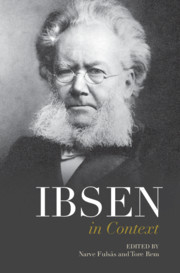Book contents
- Ibsen in Context
- Ibsen in Context
- Copyright page
- Contents
- Figures
- Contributors
- Preface
- Notes on the text
- Chronology
- Part I Life and Career
- Part II Culture and Society
- Chapter 4 Genres
- Chapter 5 Realism
- Chapter 6 Theatre
- Chapter 7 Visual Arts
- Chapter 8 Music
- Chapter 9 Philosophy
- Chapter 10 Science
- Chapter 11 Feminism
- Chapter 12 Capitalism
- Part III Scandinavian Reception
- Part IV Internationalization
- Part V Afterlives
- Further Reading
- Index
Chapter 5 - Realism
from Part II - Culture and Society
Published online by Cambridge University Press: 23 April 2021
- Ibsen in Context
- Ibsen in Context
- Copyright page
- Contents
- Figures
- Contributors
- Preface
- Notes on the text
- Chronology
- Part I Life and Career
- Part II Culture and Society
- Chapter 4 Genres
- Chapter 5 Realism
- Chapter 6 Theatre
- Chapter 7 Visual Arts
- Chapter 8 Music
- Chapter 9 Philosophy
- Chapter 10 Science
- Chapter 11 Feminism
- Chapter 12 Capitalism
- Part III Scandinavian Reception
- Part IV Internationalization
- Part V Afterlives
- Further Reading
- Index
Summary
Ibsen, more than any other playwright, established realism as a vital mode in the theatre. The nature of Ibsen’s realism, however, warrants careful description. Realism for Ibsen is simultaneously a theatrical technique and a philosophical stance. We find realism at work in Ibsen’s dialogue, scenery and characterization, as well as in the plays’ relentless critique of bourgeois ideals. Ibsen was not the first realist dramatist, but he remains its most influential practitioner. This legacy is somewhat ironic, given the disturbing surreality that leeches through the realist surface of his plays. And yet, the spark of recognition the plays continue to ignite bears witness to realism’s effectiveness, as audiences continue to find themselves represented, in all their faults, in his towering dramas.
- Type
- Chapter
- Information
- Ibsen in Context , pp. 37 - 45Publisher: Cambridge University PressPrint publication year: 2021
- 1
- Cited by

